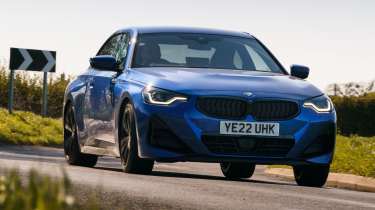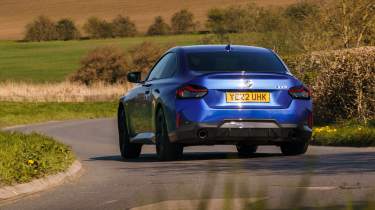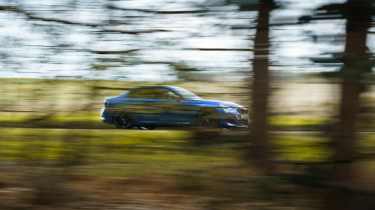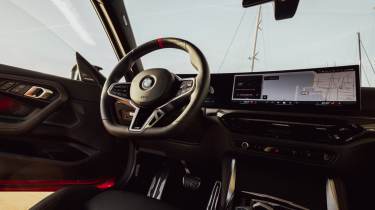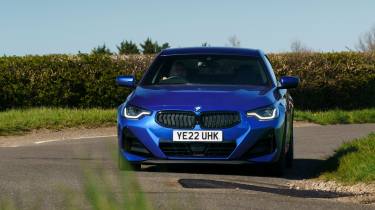BMW 230i 2025 review – a BMW coupe of the old school?
BMW’s 230i has been refreshed. Is it still BMW’s undercover driver’s car?
BMW has lightly updated its rear-drive-biased 2-series Coupe for 2024 and beyond, with the model adopting the latest curved digital screen display on the inside, among a number of other small revisions.
The two-door Coupe is one of several BMW model ranges wearing the 2-series badge, including the transverse-engined four-door Gran Coupe and the Active Tourer MPV. The latter aren’t necessarily models you’d associate with core BMW performance car tenets but the Coupe is a BMW in the more traditional mould: a relatively small, engaging, rear-driven coupe. In the context of the 2020s, this left-field VW Golf GTI alternative is something of a novel offering.
Indeed, even looking as it does (a little weird, from all angles, let’s be honest), the BMW 230i is perhaps the most ‘traditional’ BMW the Bavarian marque still makes. It’s a two-door saloon, with a long bonnet under which resides a longitudinally mounted four-cylinder engine, sending 242bhp to the rear wheels. Save being about 5bhp up and wilfully omitting the automatic gearbox, that description is a dead ringer for the E30 M3 Sport Evolution of almost 35 years ago.
The G42 2-series Coupe rides on the same CLAR platform as the current 3- and 4-series, but is closer in footprint and layout to their ancestors. With all this in mind, the prospect of going for a drive in one of the least sporty versions of BMW’s smallest coupe is inexplicably compelling. Can it punch above its weight and faithfully interpret the appeal of a modern-classic BMW?
Pop the pillarless door, step inside and fire it up, and you’re not met with the thrum of a naturally aspirated motorsport-bred engine. Rather, the distant woofle of the B48 four-cylinder turbo. That’s an engine with which many readers will be familiar: it’s been around for a decade performing various roles, in everything from Minis to Morgans (and, of course, a number of BMWs from the 1-series to the 7-series).
More reviews
Group tests
- BMW M3 CS v Litchfield BMW M2: which makes the better track car?
- BMW 230i M Sport v Volkswagen Golf GTI Clubsport
In-depth reviews
Long term tests
Reviews
In the 2-series the same engine in different tunes spans the 220i and the more powerful 241bhp, 295lb ft 230i, on which we’ll focus for the moment. All 2-series models exclusively use the eight-speed automatic transmission that’s found in most of the current new cars on BMW forecourts, save for a few M2s and the Z4 Handschalter. For the performance it offers, the B48 delivers decent efficiency when you’re not pressing on. More than an indicated 40mpg is achievable on a run.
> BMW i8 – the car world's greatest misses
The only pathway up the range from the 230i is the all-wheel-drive xDrive-equipped BMW M240i. That makes the 230i the most powerful rear-driven 2-series you can get south of the full-on M2.
Though that sounds like an important billing for the turbo four-banger, it doesn’t bring much in terms of theatre. It is an effective mill, pulling well through the rev range but there’s no performance car pomp. It’s more a machine of utility, that you extract performance from rather than play like an instrument.
Driving the rear wheels via BMW’s eight-speed automatic transmission, it’ll get the 230i to 62mph in 5.9 seconds, on the way to a limited 155mph top speed. Even in the context of modern performance cars, which spoil us somewhat in outright pace, the 230i still feels brisk enough for a middling small BMW coupe, even if it doesn’t sing along the way. The auto ’box could be described as adequate if not engaging too. It gets the job done but is neither standard-settingly brisk nor memorable in the way it brings the gears home.
If it’s all sounding a bit disappointing up to this point, fear not. The 230’s star turn is in its inherent balance. This is an enjoyable car to get up on its toes. It rides on passive rather than adaptive dampers and, yes, it’s a bit crashy at low speeds, and other cars can offer more control when really pressing on, but it doesn’t get in the way of enjoying the car. And chances are, you’ll be enjoying it a great deal. At a middling pace, you can find a pleasing flow that the 230 just leans into. Switch all the systems off and it can laterally express itself, both under power and in terms of its natural on-limit balance.
> BMW 1-series review – Munich’s Audi A3 rival gains focus
The steering is a little nervous, easily wandering a degree or two off-centre. The steering itself is appropriately ratioed and weighted for a performance car, if not shot through with feel. The biggest drawback is the wheel itself, with a rim that’s overly thick to the point that your hand may cramp from gripping it over an extended journey. It’s been a problem with BMWs for too long, that needs to change with the upcoming Neue Klasse model generation.
Elsewhere inside, the 2025 2-series is near the opposite of a traditional BMW, certainly in terms of the curved display. The pre-update 2-series Coupe had a digital display which was separate from the central display. This new panel containing both is the biggest change to BMW cabins’ layout since iDrive arrived in the E65 7-series two decades ago. It sits well in the cabin, admittedly – far from the slab of pixelated tokenism as seen in some installations – though cars so equipped are now quite difficult to tell apart from the inside. How 4-series buyers will feel about the 2-series having a cabin that looks more or less the same at a glance, remains to be determined.
If only the graphics for the driver’s display were as distinctive as analogue BMW dials of old. Though there has been a bit of a button cull, including the climate controls which now sit at the bottom of the screen in their own permanent ribbon of pixels, there’s still a rotary controller you can use to navigate the screen. We’ll take all the vestigial analogue interfaces we can get. The wireless smartphone mirroring works well once it's set up, though it did freeze a few times during our test.
Enough about screens, what about the rest of the cabin? Well, BMW’s interior fit and finish continues to impress and the 2-series’ cabin is very well screwed together with pleasant materials. It’s spacious enough to seat four adults for a middling journey, if not a trans-continental tour. The seats are supportive and can be positioned precisely, if not electrically, on the car tested. (Electric-adjust front seats, with memory settings, are an option.) They’re also trimmed in Alcantara with a few flashes of M colours. Unfortunately, it’s not just the button count that’s shrinking. The gear selector in BMWs is a bit apologetic and awkward to use these days, too.
All in, though, the 2-series isn’t apologetic in walking in the footsteps of the old E46, as a compact and accessible BMW coupe, albeit with a light touch. If only it were as handsome as its predecessors.
Price and rivals
At the time of writing (December 2024) the BMW 230i M Sport starts from £41,905, which is almost £2000 up on where the VW Golf GTI starts. The Golf is more powerful than the BMW but matches it to 62mph, so while you’re getting more potency for your money, you’re getting no more performance, on paper at least. There are no equivalents to be had from Mercedes or Audi, at least dynamically. A Mercedes CLA coupe is stylish but expensive; for BMW 230 money you get the tepid CLA 200.
The Mercedes-AMG CLA 35, which is quicker and more powerful, starts from £49,875. At that point, you’re in M240i xDrive territory, which can be had from £48,045. New on the scene from inside Munich of course, is the BMW M235, an altogether different 2-series, again for more money than the price of the unrelated rear-driven coupe.
